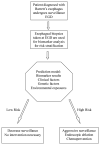Predicting Neoplastic Progression in Barrett's Esophagus
- PMID: 21552467
- PMCID: PMC3087308
Predicting Neoplastic Progression in Barrett's Esophagus
Abstract
Patients with Barrett's esophagus have a significantly increased risk of esophageal adenocarcinoma, 40-125 times higher than the general population. Since only a small fraction of Barrett's esophagus patients will actually progress to esophageal adenocarcinoma, there is a need to develop markers that may accurately predict which patients with Barrett's esophagus are likely to have aggressive disease and progress to cancer versus patients who will remain histologically stable and have a benign course. This would allow for better risk stratification of patients with Barrett's esophagus in order to target aggressive surveillance and intervention towards only those patients at highest risk for neoplastic progression. Predictive biomarkers may thus have significant clinical utility in the management of Barrett's esophagus patients. The detection of dysplasia in esophageal biopsies is currently the only standard method used in clinical practice as a marker for increased risk of cancer. However, dysplasia has not been a accurate or reliable marker for predicting malignant progression and suffers from poor interobserver agreement among pathologists and sampling error. A multitude of potential biomarkers have been studied over the years. It is likely that the best model for predicting progression to esophageal adenocarcinoma in Barrett's esophagus patients will ultimately involve a combination of biomarkers, dysplasia grade and other pathological characteristics, as well as clinical and demographic attributes. In this review, we will discuss the most promising biomarkers that have been studied thus far.
Figures
Similar articles
-
Surveillance in Barrett's esophagus: an audit of practice.Dig Dis Sci. 2010 Jun;55(6):1615-21. doi: 10.1007/s10620-009-0917-y. Epub 2009 Aug 11. Dig Dis Sci. 2010. PMID: 19669878
-
The diagnosis and management of Barrett's esophagus.Adv Surg. 1999;33:29-68. Adv Surg. 1999. PMID: 10572561 Review.
-
Malignant progression in Barrett's esophagus: pathology and molecular biology.Recent Results Cancer Res. 2000;155:29-41. doi: 10.1007/978-3-642-59600-1_3. Recent Results Cancer Res. 2000. PMID: 10693236 Review.
-
Diagnosis and Management of Low-Grade Dysplasia in Barrett's Esophagus: Expert Review From the Clinical Practice Updates Committee of the American Gastroenterological Association.Gastroenterology. 2016 Nov;151(5):822-835. doi: 10.1053/j.gastro.2016.09.040. Epub 2016 Oct 1. Gastroenterology. 2016. PMID: 27702561 Review.
-
Anti-phosphorylated histone H3 expression in Barrett's esophagus, low-grade dysplasia, high-grade dysplasia, and adenocarcinoma.Mod Pathol. 2009 Dec;22(12):1612-21. doi: 10.1038/modpathol.2009.133. Epub 2009 Sep 4. Mod Pathol. 2009. PMID: 19734842
Cited by
-
Barrett's esophagus: an exaggerated risk?Ann Gastroenterol. 2012;25(1):79-80. Ann Gastroenterol. 2012. PMID: 24713799 Free PMC article. No abstract available.
-
Clinical and Endoscopic Differences Between Patients With Barrett's Esophagus With and Without Dysplasia/Adenocarcinoma.Cureus. 2023 Oct 1;15(10):e46323. doi: 10.7759/cureus.46323. eCollection 2023 Oct. Cureus. 2023. PMID: 37916254 Free PMC article.
-
Mitogen activated protein kinase kinase kinase 3 (MAP3K3/MEKK3) overexpression is an early event in esophageal tumorigenesis and is a predictor of poor disease prognosis.BMC Cancer. 2014 Jan 2;14:2. doi: 10.1186/1471-2407-14-2. BMC Cancer. 2014. PMID: 24383423 Free PMC article.
-
SPT6 loss permits the transdifferentiation of keratinocytes into an intestinal fate that resembles Barrett's metaplasia.iScience. 2021 Sep 11;24(10):103121. doi: 10.1016/j.isci.2021.103121. eCollection 2021 Oct 22. iScience. 2021. PMID: 34622168 Free PMC article.
-
SOX2 as a novel marker to predict neoplastic progression in Barrett's esophagus.Am J Gastroenterol. 2015 Oct;110(10):1420-8. doi: 10.1038/ajg.2015.260. Epub 2015 Sep 1. Am J Gastroenterol. 2015. PMID: 26323187
References
-
- Shaheen N, Ransohoff DF. Gastroesophageal reflux, Barrett esophagus, and esophageal cancer: clinical applications. Jama. 2002;287:1982–6. - PubMed
-
- Ronkainen J, Aro P, Storskrubb T, et al. Prevalence of Barrett's esophagus in the general population: an endoscopic study. Gastroenterology. 2005;129:1825–31. - PubMed
-
- Hameeteman W, Tytgat GN, Houthoff HJ, et al. Barrett's esophagus: development of dysplasia and adenocarcinoma. Gastroenterology. 1989;96:1249–56. - PubMed
-
- Cameron AJ, Ott BJ, Payne WS. The incidence of adenocarcinoma in columnar-lined (Barrett's) esophagus. N Engl J Med. 1985;313:857–9. - PubMed
-
- Williamson WA, Ellis FH, Jr., Gibb SP, et al. Barrett's esophagus. Prevalence and incidence of adenocarcinoma. Arch Intern Med. 1991;151:2212–6. - PubMed
Grants and funding
LinkOut - more resources
Full Text Sources
Other Literature Sources

